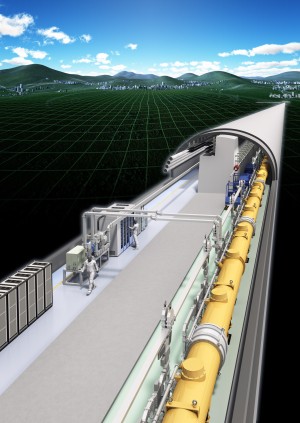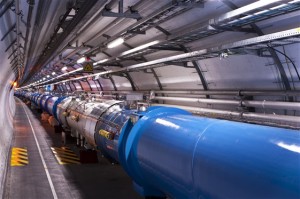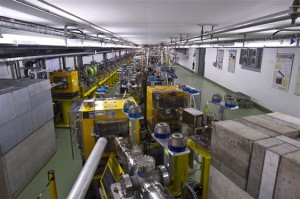
The International Linear Collider – about to publish its Technical Design Report. Image: ILC, Rey.Hori
The past few years, we have made a great deal of progress in developing and demonstrating the enabling technologies needed for a linear collider for the two concepts that are being pursued: the International Linear Collider (ILC), based on Superconducting RF acceleration; and a potentially higher-energy option, the Compact Linear Collider study (CLIC), based on a two-beam acceleration scheme. Although the two-beam concept still has a way to go before a real project can be proposed, at a recent workshop at CERN it became clear that there is also considerable interest in using CLIC structures powered by 12-GHz klystrons for other applications such as free-electron lasers and compact medical accelerators.
The Global Design Effort has completed and documented the ILC R&D accomplishments and demonstrations in a draft Technical Design Report (TDR), as well as presented a technical design for the ILC. The TDR also includes volumes on ILC physics and a detector detailed baseline design. It is presently undergoing final technical and cost reviews and will be published by summer. The completion of the TDR will mark the completion of what might be called the ILC concept-to-design phase. The new Linear Collider Collaboration is being charged with integrating the ongoing efforts for the ILC, CLIC and physics and detectors, and leading the next phase of the effort, from design to a project.
The discovery of the Higgs-like particle at the Large Hadron Collider has provided added strong physics motivation for a future complementary lepton collider. The Higgs is a completely new type of particle, unlike any other (for example it has zero spin and couples to mass). To understand the underlying physics will require that we determine its spin, couplings, and other characteristics. That will require a comprehensive future programme, first at the LHC, and then on a complementary electron-positron collider. If this particle is indeed a result of the mechanism for creating mass as proposed by Peter Higgs and others, then we must understand whether it is the simple Higgs mechanism or an alternative. The worldwide community is discussing various ideas for how to best pursue these questions, both at the LHC, and with a dedicated future electron-positron Higgs factory. The leading candidate for such a Higgs factory is a staged version of the ILC, beginning at 250 GeV and then upgradable to higher energy in the longer term.
The Japanese have proposed two candidate mountainous sites for the ILC, one in the Kyushu district and the other in the Tohoku district, and are discussing plans for building a Higgs factory as the initial step of a staged ILC. The sites in Japan are high enough into the mountains to provide a stable granite geology for an underground tunnel and facility. The GDE TDR includes both designs for a more traditional deep underground site and for such a mountainous site. The Japanese sites will have near horizontal access (an advantage), but further distances to the surface (a disadvantage). Overall, the GDE has concluded that the Japanese mountainous sites represent viable options for the ILC and that such a facility will be comparable in cost and for technical design, performance and risk as a deep underground site.
We very much welcome the timely Japanese proposal to host the ILC. The remaining work of the GDE and initial work of the LCC will focus on site-specific designs, costing and planning to create an international facility in the Japanese mountains. As we ponder such a future for the ILC and for particle physicists in the Japanese mountains, we might recall William Blake’s poetic words, “Great things are done when men and mountains meet.”





Recent Comments